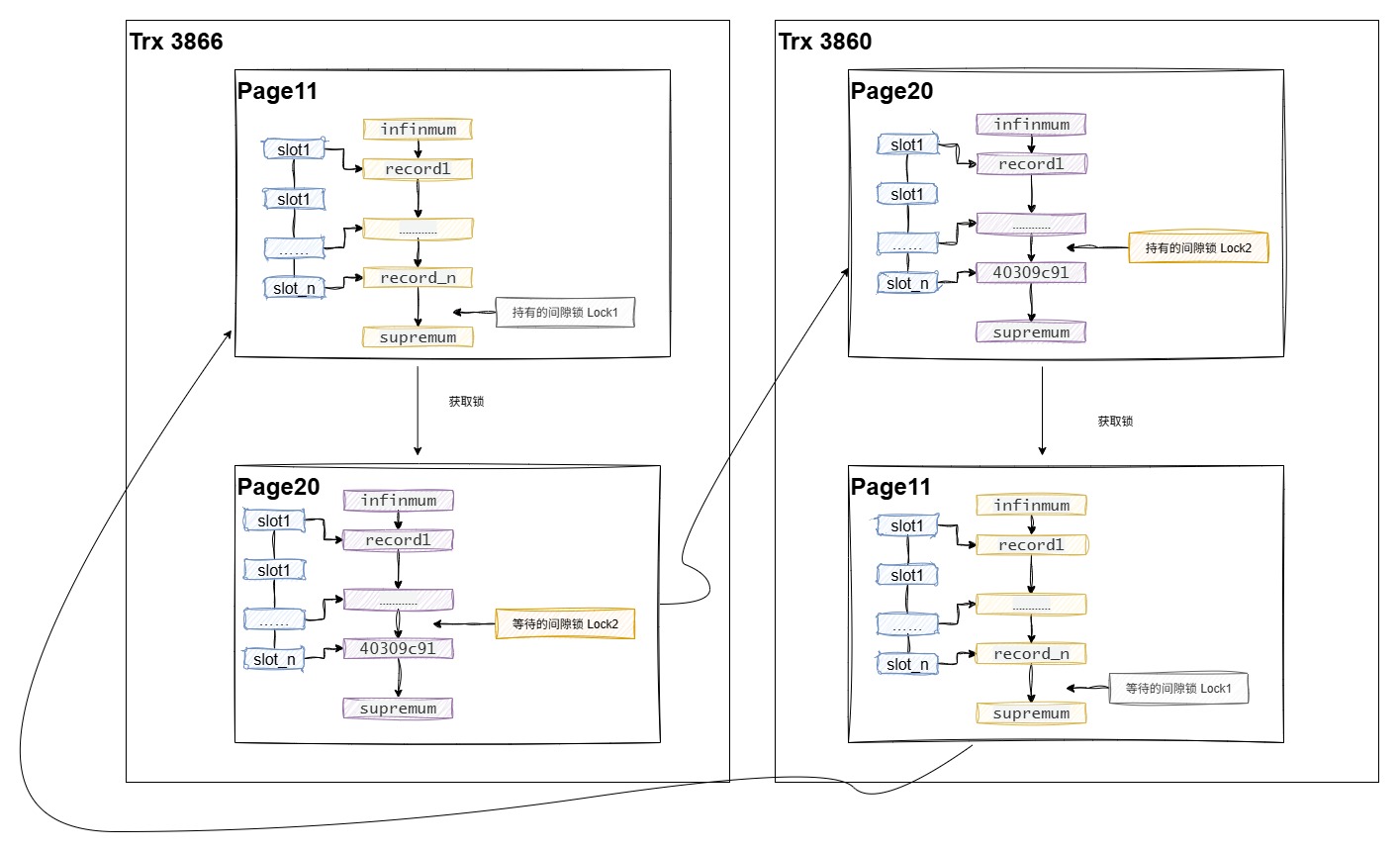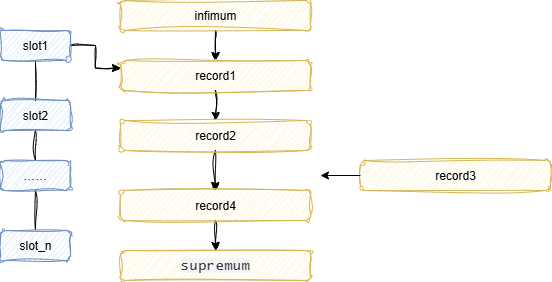前言
本文选用的 MySQL 版本:8.4.6
使用的数据
表结构:
sql
DROP TABLE IF EXISTS store_snapshot_ext;
DROP TABLE IF EXISTS store_snapshot;
create table store_snapshot
(
id varchar(32) not null comment '主键'
primary key,
warehouse_id varchar(32) null comment '仓库主键',
snap_date datetime null comment '快照日期',
create_id varchar(32) null comment '创建人id',
create_time datetime null comment '创建日期',
modify_id varchar(32) null comment '更新人 id',
modify_time datetime null comment '更新时间'
)
comment '仓库快照';
create table store_snapshot_ext
(
id varchar(32) not null comment '主键'
primary key,
fk_snapshot_id varchar(32) null comment '快照外键',
ext_attr varchar(32) null comment '扩展属性',
create_id varchar(32) null comment '创建人id',
create_time datetime null comment '创建日期',
modify_id varchar(32) null comment '更新人 id',
modify_time datetime null comment '更新时间',
constraint store_snapshot_ext___fk_snapshot_id
foreign key (fk_snapshot_id) references store_snapshot (id)
)
comment '仓库快照扩展属性';这里使用 Java 语言模拟并发情况下对数据的插入:
java
import cn.hutool.core.date.DateTime;
import cn.hutool.core.util.RandomUtil;
import org.junit.jupiter.api.Test;
import org.junit.jupiter.api.extension.ExtendWith;
import org.mybatis.spring.annotation.MapperScan;
import org.springframework.boot.SpringApplication;
import org.springframework.boot.autoconfigure.SpringBootApplication;
import org.springframework.boot.test.context.SpringBootTest;
import org.springframework.test.context.junit.jupiter.SpringExtension;
import org.springframework.transaction.PlatformTransactionManager;
import org.springframework.transaction.TransactionDefinition;
import org.springframework.transaction.TransactionStatus;
import org.springframework.transaction.annotation.EnableTransactionManagement;
import org.springframework.transaction.support.DefaultTransactionDefinition;
import org.tea.common.entity.StoreSnapshot;
import org.tea.common.entity.StoreSnapshotExt;
import org.tea.common.mapper.StoreSnapshotExtMapper;
import org.tea.common.mapper.StoreSnapshotMapper;
import javax.annotation.Resource;
import java.util.UUID;
import java.util.concurrent.CountDownLatch;
@ExtendWith(SpringExtension.class)
@SpringBootTest(classes = StoreSnapshotApplication.class)
public class StoreSnapBenchTest {
@Resource
private PlatformTransactionManager txManager;
@Resource
private StoreSnapshotMapper storeSnapshotMapper;
@Resource
private StoreSnapshotExtMapper storeSnapshotExtMapper;
@Test
public void batchTest() throws InterruptedException {
Thread[] ts = new Thread[10];
CountDownLatch startLatch = new CountDownLatch(1);
CountDownLatch endLatch = new CountDownLatch(ts.length);
for (int i = 0; i < ts.length; i++) {
ts[i] = new Thread(() -> {
DefaultTransactionDefinition definition = new DefaultTransactionDefinition();
// 设置事务隔离级别为 "可重复读"
definition.setIsolationLevel(TransactionDefinition.ISOLATION_REPEATABLE_READ);
TransactionStatus status = txManager.getTransaction(definition);
try {
/**
提高事务竞争的激烈度
*/
startLatch.await();
/**
一般情况下,不会使用如下的循环方式来插入数据,这里这么做的目的是为了
提高事务的处理时间,增大锁的竞争激烈度
*/
for (int j = 0; j < 2000; j++) {
StoreSnapshot snapshot = new StoreSnapshot();
// 使用 UUID 的方式来引发 Page 分裂
snapshot.setId(UUID.randomUUID().toString().replaceAll("-", ""));
snapshot.setWarehouseId("warehouse_1");
snapshot.setSnapDate(new DateTime());
snapshot.init();
storeSnapshotMapper.insertSelective(snapshot);
StoreSnapshotExt snapshotExt = new StoreSnapshotExt();
snapshotExt.setId(UUID.randomUUID().toString().replaceAll("-", ""));
snapshotExt.setExtAttr(RandomUtil.randomString(32));
// 注意这里的外键,后文会分析这个外键带来的一些影响
snapshotExt.setFkSnapshotId(snapshot.getId());
storeSnapshotExtMapper.insertSelective(snapshotExt);
}
txManager.commit(status);
} catch (InterruptedException e) {
txManager.rollback(status);
throw new RuntimeException(e);
} finally {
endLatch.countDown();
}
});
}
for (Thread t : ts) {
t.start();
}
startLatch.countDown();
endLatch.await();
}
}
@SpringBootApplication
@EnableTransactionManagement
@MapperScan("org.tea.*.mapper")
class StoreSnapshotApplication {
public static void main(String[] args) {
SpringApplication.run(StoreSnapshotApplication.class, args);
}
}在执行完上面的测试用例后,查看 MySQL InnoDB 的状态信息,发现已经出现了死锁:
txt
------------------------
LATEST DETECTED DEADLOCK
------------------------
2025-08-26 21:01:55 135637563962944
*** (1) TRANSACTION:
TRANSACTION 3866, ACTIVE 2 sec inserting
mysql tables in use 1, locked 1
LOCK WAIT 27 lock struct(s), heap size 8312, 220 row lock(s), undo log entries 430
MySQL thread id 17, OS thread handle 135637553456704, query id 8736 localhost ::1 root update
INSERT INTO store_snapshot (create_id, warehouse_id, snap_date, modify_id, id, modify_time, create_time) VALUES ('system', 'warehouse_1', '2025-08-26 21:01:54', 'system', '402ce43f650a483eb0c9c5138e50d6f0', '2025-08-26 21:01:54', '2025-08-26 21:01:54')
*** (1) HOLDS THE LOCK(S):
RECORD LOCKS space id 10 page no 11 n bits 240 index PRIMARY of table `lxh_db`.`store_snapshot` trx id 3866 lock_mode X
Record lock, heap no 1 PHYSICAL RECORD: n_fields 1; compact format; info bits 0
0: len 8; hex 73757072656d756d; asc supremum;;
*** (1) WAITING FOR THIS LOCK TO BE GRANTED:
RECORD LOCKS space id 10 page no 20 n bits 160 index PRIMARY of table `lxh_db`.`store_snapshot` trx id 3866 lock_mode X locks gap before rec insert intention waiting
Record lock, heap no 5 PHYSICAL RECORD: n_fields 9; compact format; info bits 0
0: len 30; hex 343033303963393162373166343731633936323164616565643434666363; asc 40309c91b71f471c9621daeed44fcc; (total 32 bytes);
1: len 6; hex 000000000f14; asc ;;
2: len 7; hex 82000001070630; asc 0;;
3: len 11; hex 77617265686f7573655f31; asc warehouse_1;;
4: len 5; hex 99b7755074; asc uPt;;
5: len 6; hex 73797374656d; asc system;;
6: len 5; hex 99b7755074; asc uPt;;
7: len 6; hex 73797374656d; asc system;;
8: len 5; hex 99b7755074; asc uPt;;
*** (2) TRANSACTION:
TRANSACTION 3860, ACTIVE 3 sec inserting
mysql tables in use 1, locked 1
LOCK WAIT 46 lock struct(s), heap size 24696, 1258 row lock(s), undo log entries 2474
MySQL thread id 11, OS thread handle 135637890971200, query id 12330 localhost ::1 root update
INSERT INTO store_snapshot (create_id, warehouse_id, snap_date, modify_id, id, modify_time, create_time) VALUES ('system', 'warehouse_1', '2025-08-26 21:01:55', 'system', '917f3578682c467384e520fd6c00b86d', '2025-08-26 21:01:55', '2025-08-26 21:01:55')
*** (2) HOLDS THE LOCK(S):
RECORD LOCKS space id 10 page no 20 n bits 160 index PRIMARY of table `lxh_db`.`store_snapshot` trx id 3860 lock_mode X locks gap before rec
Record lock, heap no 3 PHYSICAL RECORD: n_fields 9; compact format; info bits 0
0: len 30; hex 336661623363323037333232346465666263363762333630363763623666; asc 3fab3c2073224defbc67b36067cb6f; (total 32 bytes);
1: len 6; hex 000000000f14; asc ;;
2: len 7; hex 82000000932d80; asc - ;;
3: len 11; hex 77617265686f7573655f31; asc warehouse_1;;
4: len 5; hex 99b7755076; asc uPv;;
5: len 6; hex 73797374656d; asc system;;
6: len 5; hex 99b7755076; asc uPv;;
7: len 6; hex 73797374656d; asc system;;
8: len 5; hex 99b7755076; asc uPv;;
Record lock, heap no 4 PHYSICAL RECORD: n_fields 9; compact format; info bits 0
0: len 30; hex 336664326234626538643463343338326130303764383431366364613536; asc 3fd2b4be8d4c4382a007d8416cda56; (total 32 bytes);
1: len 6; hex 000000000f14; asc ;;
2: len 7; hex 82000000903800; asc 8 ;;
3: len 11; hex 77617265686f7573655f31; asc warehouse_1;;
4: len 5; hex 99b7755076; asc uPv;;
5: len 6; hex 73797374656d; asc system;;
6: len 5; hex 99b7755076; asc uPv;;
7: len 6; hex 73797374656d; asc system;;
8: len 5; hex 99b7755076; asc uPv;;
Record lock, heap no 5 PHYSICAL RECORD: n_fields 9; compact format; info bits 0
0: len 30; hex 343033303963393162373166343731633936323164616565643434666363; asc 40309c91b71f471c9621daeed44fcc; (total 32 bytes);
1: len 6; hex 000000000f14; asc ;;
2: len 7; hex 82000001070630; asc 0;;
3: len 11; hex 77617265686f7573655f31; asc warehouse_1;;
4: len 5; hex 99b7755074; asc uPt;;
5: len 6; hex 73797374656d; asc system;;
6: len 5; hex 99b7755074; asc uPt;;
7: len 6; hex 73797374656d; asc system;;
8: len 5; hex 99b7755074; asc uPt;;
Record lock, heap no 93 PHYSICAL RECORD: n_fields 9; compact format; info bits 0
0: len 30; hex 336664396165326435663738346237656161346134323336643031643366; asc 3fd9ae2d5f784b7eaa4a4236d01d3f; (total 32 bytes);
1: len 6; hex 000000000f14; asc ;;
2: len 7; hex 82000000a81784; asc ;;
3: len 11; hex 77617265686f7573655f31; asc warehouse_1;;
4: len 5; hex 99b7755077; asc uPw;;
5: len 6; hex 73797374656d; asc system;;
6: len 5; hex 99b7755077; asc uPw;;
7: len 6; hex 73797374656d; asc system;;
8: len 5; hex 99b7755077; asc uPw;;
*** (2) WAITING FOR THIS LOCK TO BE GRANTED:
RECORD LOCKS space id 10 page no 11 n bits 240 index PRIMARY of table `lxh_db`.`store_snapshot` trx id 3860 lock_mode X insert intention waiting
Record lock, heap no 1 PHYSICAL RECORD: n_fields 1; compact format; info bits 0
0: len 8; hex 73757072656d756d; asc supremum;;
*** WE ROLL BACK TRANSACTION (1)
------------
TRANSACTIONS
------------可以看到,在日志中,事务 3866 持有一个页号为 11,supremum (相当于双链表的尾部哑节点) 的间隙锁,在等待页号为 20,主键为 40309c91b71f471c9621daeed44fcc 的间隙锁;同时,事务 3860 持有页号为 20,主键为 40309c91b71f471c9621daeed44fcc 的间隙锁,同时在等待页号为 10 的 supremum 的间隙锁。这两个事务构成了循环回路,并且在相互等待,因此形成了死锁,具体的图示如下所示:

具体分析
-
查询语句的加锁
MySQL的的一般SELECT语句在非串行化隔离级别下是通过一致性读的方式进行读取,本身不会对记录加锁,但是在存在外键约束的情况下,依旧会对关联的外键约束记录上加上S型的记录锁,如果关联的外键约束没有被找到,在"可重复读"的隔离级别下,会在外键记录附近加上间隙锁由于这里插入语句的外键都能被找到,因此这里的外键不是产生间隙锁的原因
-
INSERT语句的加锁单纯的
INSERT语句在插入时加上的是一种特殊的记录锁,不同事务的插入意向锁不会相互阻塞,但是在插入的记录行的所处位置存在间隙锁的情况下,会为当前的INSERT记录加上 插入意向锁在主键重复的情况下,隔离级别为 "可重复读" 或 "串行化" 的情况下,会为插入的记录加上
S型的Next-Key锁。在这种情况下,如果原来待插入行的事务回滚了,由于本身持有的S型锁无法再获取到独占锁,就有可能会引发死锁[2]。由于这里的主键都是
UUID,不存在重复主键,并且结合相关的日志信息,并不是由于单纯的INSERT语句导致的死锁 -
Page 的分裂
当插入的记录的主键不连续时,
MySQL为了维护聚簇索引的顺序,可能会引发页的分裂。在事务隔离级别为 "可重复读"或"串行化" 的情况下,对分裂的数据进行迁移的过程中,相当于对数据执行了更新的操作,按照MySQL对于UPDATE语句的加锁情况[2],会在记录上加上 Next-Key (记录锁和间隙锁),因此事务3860会持有记录40309c91b71f471c9621daeed44fcc的间隙锁;而为了防止在分裂维护过程中重新插入数据,可能不得不为相关页记录的supremum加上间隙锁,以维护页分裂的执行过程这个过程可能如下:
插入记录前:

插入记录导致页分裂后

注意: 这里关于分页而产生的间隙锁为实际实验推断,并无实际文档与之关联。当事务隔离级别为 "读提交" 或插入的记录的主键存在顺序时,都不会出现上文描述的死锁出现
解决方案
实际上,如果事务执行速度特别快,并且在并发量不高的情况下,这种类型的死锁很难被检测到,因为需要处理的事务跨多个页,并且需要关联到两个不同页的锁本身就很难。因此,将逐行的 INSERT 语句替换为批量提交后也可以很大程度上解决这一问题
为了尽可能地避免这一类问题,推荐的一些方案如下:
- 如果没有特殊必要,可以使用隔离级别较低的事务隔离级别,因为这样可以减少实际事务处理过程中锁的数量,降低锁冲突的可能性
- 尽量使用有序的主键,不管是从性能上还是实际业务角度,都没有理由选择
UUID的理由 - 如果可以,适当减少事务的粒度,如:将一个大事务分成几个小事务,在性能和一致性上做一定的权衡
参考:
[1] https://mp.weixin.qq.com/s/9LRFYGquXWpMCeyAonNcMQ
[2] https://dev.mysql.com/doc/refman/8.0/en/innodb-locks-set.html